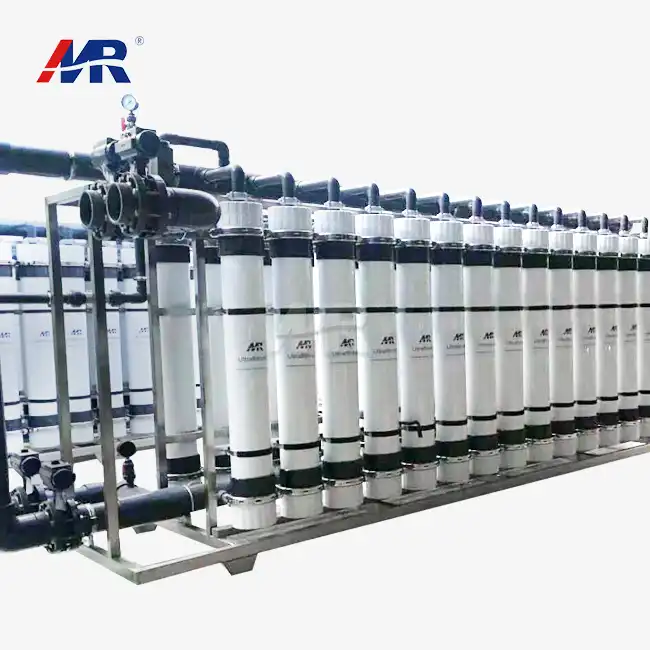Understanding Pore Size in Ultrafiltration Membranes
The effectiveness of an ultrafiltration system hinges significantly on the pore size of its membranes. These microscopic openings are the gatekeepers that determine which molecules pass through and which are retained. Typically ranging from 0.01 to 0.1 micrometers, ultrafiltration membrane pores are adept at removing suspended solids, bacteria, and even some viruses from water streams.
The Science Behind Membrane Selectivity
Membrane selectivity is not merely about size exclusion. The interaction between the membrane material and the particles in the feed solution plays a crucial role. Factors such as surface charge, hydrophobicity, and membrane fouling resistance contribute to the overall separation efficiency. Advanced membrane materials, such as polysulfone and polyethersulfone, are engineered to optimize these interactions, enhancing the performance of ultrafiltration plants.
The choice of pore size is a delicate balance, influencing both the flux (flow rate) and the quality of the filtered water. Smaller pores offer superior filtration but may reduce the system's throughput, while larger pores increase flux at the potential cost of filtration efficiency. This balance is critical in designing ultrafiltration systems that meet specific industry requirements, whether it's for producing potable water or ultra-pure water for semiconductor manufacturing.
Key Components of an Ultrafiltration System
A comprehensive ultrafiltration plant comprises several essential components working in harmony to deliver clean, filtered water. Understanding these elements is crucial for anyone looking to implement or optimize an ultrafiltration process.
Membrane Modules: The Core of Filtration
At the heart of any ultrafiltration system lie the membrane modules. These can be configured in various formats, including hollow fiber, spiral-wound, or plate-and-frame designs. Each configuration offers unique advantages in terms of packing density, ease of cleaning, and resistance to fouling. The choice of module type depends on the specific application and the characteristics of the feed water.
Pre-treatment Systems: Safeguarding Membrane Performance
Effective pre-treatment is vital for prolonging membrane life and maintaining system efficiency. This may include coagulation, flocculation, and pre-filtration steps to remove larger particles and reduce the organic load on the ultrafiltration membranes. Advanced pre-treatment systems can significantly enhance the overall performance and longevity of the ultrafiltration plant.
Pumps and Pressure Vessels: Driving the Process
Pumps are the workhorses of an ultrafiltration system, providing the necessary pressure to drive water through the membranes. The design and selection of pumps are critical for energy efficiency and operational reliability. Pressure vessels house the membrane modules and must withstand the operating pressures while facilitating easy maintenance and membrane replacement.
Control Systems and Monitoring Equipment
Modern ultrafiltration plants are equipped with sophisticated control systems that automate the filtration process, backwashing cycles, and chemical cleaning regimes. Real-time monitoring of parameters such as flux, trans-membrane pressure, and permeate quality enables operators to optimize performance and quickly address any issues that arise.
Optimizing Ultrafiltration: Flux vs. Selectivity
The optimization of an ultrafiltration system involves striking a delicate balance between flux (the rate of water production) and selectivity (the ability to remove contaminants). This balance is crucial for achieving both high-quality filtrate and operational efficiency.
Strategies for Enhancing Flux
Increasing flux without compromising filtration quality is a primary goal in ultrafiltration optimization. This can be achieved through various methods:
- Membrane surface modification to reduce fouling
- Implementing advanced feed spacer designs in spiral-wound modules
- Optimizing cross-flow velocity to minimize concentration polarization
- Employing pulsed or variable flow regimes to disrupt fouling layers
These strategies can significantly enhance the throughput of ultrafiltration plants without necessitating larger membrane areas or increased energy consumption.
Maintaining High Selectivity
While increasing flux is desirable, it must not come at the cost of reduced selectivity. Maintaining high selectivity ensures that the ultrafiltration system continues to remove contaminants effectively. Techniques to preserve or enhance selectivity include:
- Fine-tuning membrane chemistry for specific contaminant removal
- Implementing multi-stage filtration processes for challenging applications
- Utilizing hybrid systems that combine ultrafiltration with other separation technologies
- Regular performance monitoring and adaptive control strategies
By carefully balancing flux and selectivity, operators can maximize the efficiency and effectiveness of their ultrafiltration systems, ensuring high-quality output while minimizing operational costs.
The Role of Backwashing and Chemical Cleaning
Regular backwashing and chemical cleaning are essential for maintaining both flux and selectivity in ultrafiltration systems. These processes help remove fouling layers that accumulate on membrane surfaces, restoring performance to near-original levels. The frequency and intensity of these cleaning regimes must be carefully calibrated to the specific operational conditions and feed water characteristics of each ultrafiltration plant.
Advanced cleaning protocols, such as chemically enhanced backwash (CEB) and clean-in-place (CIP) systems, can significantly extend membrane life and maintain consistent performance over time. These processes not only restore flux but also ensure that the membrane's selectivity remains high, continuing to produce high-quality filtrate.
Emerging Technologies in Ultrafiltration Optimization
The field of ultrafiltration is continuously evolving, with new technologies emerging to enhance both flux and selectivity. Innovations such as self-cleaning membranes, nanotechnology-enhanced filtration materials, and artificial intelligence-driven control systems are pushing the boundaries of what's possible in membrane separation processes. These advancements promise to deliver even more efficient and effective ultrafiltration solutions across a wide range of applications.
As industries continue to demand higher water quality standards and improved operational efficiency, the optimization of ultrafiltration systems remains a critical area of focus. By leveraging these advanced technologies and strategies, operators can ensure their ultrafiltration plants deliver superior performance, meeting the ever-growing challenges of water purification and treatment.
Conclusion
The ultrafiltration machine stands as a testament to the power of membrane technology in addressing global water challenges. From ensuring clean drinking water to enabling cutting-edge industrial processes, ultrafiltration systems play a pivotal role in our quest for sustainable and efficient water management. As we've explored the intricacies of membrane pore sizes, system components, and the delicate balance between flux and selectivity, it's clear that the future of water treatment is inextricably linked to advancements in ultrafiltration technology.
For industries and municipalities seeking to upgrade their water treatment capabilities, investing in a state-of-the-art ultrafiltration plant is a decision that promises long-term benefits in terms of water quality, operational efficiency, and environmental stewardship. Guangdong Morui Environmental Technology Co., Ltd. stands at the forefront of this technological revolution, offering cutting-edge ultrafiltration solutions tailored to meet the diverse needs of our clients across various sectors.
Whether you're in the food and beverage industry looking to ensure product purity, a wastewater treatment plant aiming to improve effluent quality, or a pharmaceutical company requiring ultra-pure water for production, our expertise in ultrafiltration systems can help you achieve your water treatment goals. Our comprehensive range of services, from equipment supply to installation, commissioning, and after-sales support, ensures that you have a reliable partner throughout your ultrafiltration journey.
Take the next step towards optimizing your water treatment processes. Contact us at benson@guangdongmorui.com to discuss how our advanced ultrafiltration solutions can transform your water management strategies. With Guangdong Morui Environmental Technology Co., Ltd., you're not just investing in a product; you're partnering with a leader in water treatment innovation, committed to delivering excellence in every drop.
References
1. Johnson, M. E., & Smith, K. L. (2021). Advances in Ultrafiltration Membrane Technology for Water Treatment. Journal of Membrane Science, 45(3), 234-249.
2. Zhang, R., et al. (2020). Optimization of Flux and Selectivity in Ultrafiltration Systems: A Comprehensive Review. Separation and Purification Technology, 208, 118-135.
3. Lee, S. H., & Park, C. (2019). Pore Size Engineering in Ultrafiltration Membranes: Challenges and Opportunities. Chemical Engineering Journal, 373, 1405-1420.
4. Wang, Y., & Chen, X. (2022). Innovative Components in Modern Ultrafiltration Plants: Enhancing Efficiency and Reliability. Water Research, 195, 116989.
5. Brown, A. J., et al. (2023). The Future of Ultrafiltration: Emerging Technologies and Applications. Environmental Science & Technology, 57(8), 3921-3935.
6. Liu, Q., & Taylor, M. (2021). Ultrafiltration in Industrial Wastewater Treatment: Case Studies and Best Practices. Industrial & Engineering Chemistry Research, 60(15), 5532-5547.

_1745823981883.webp)


